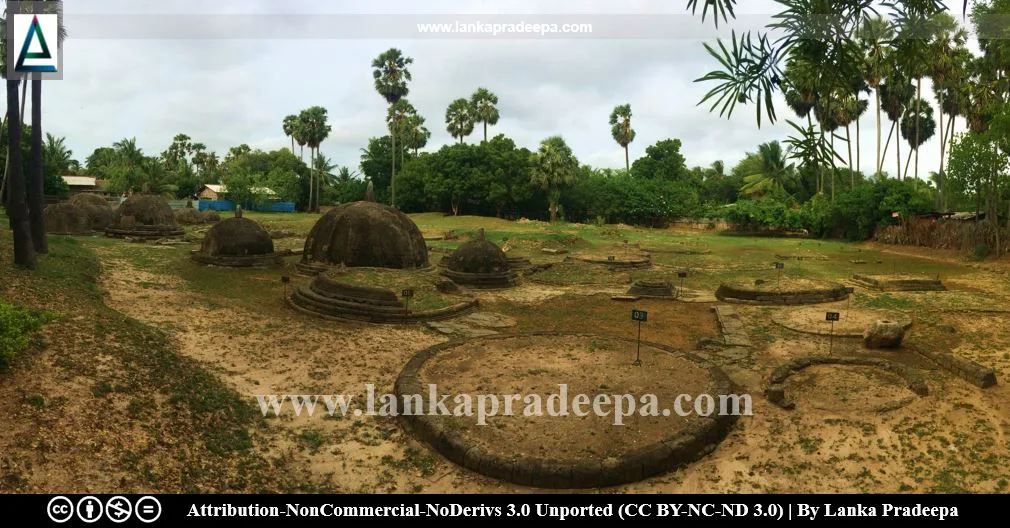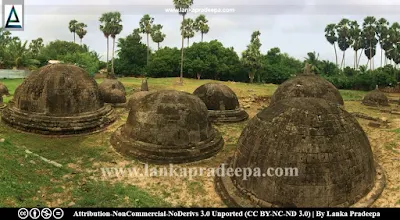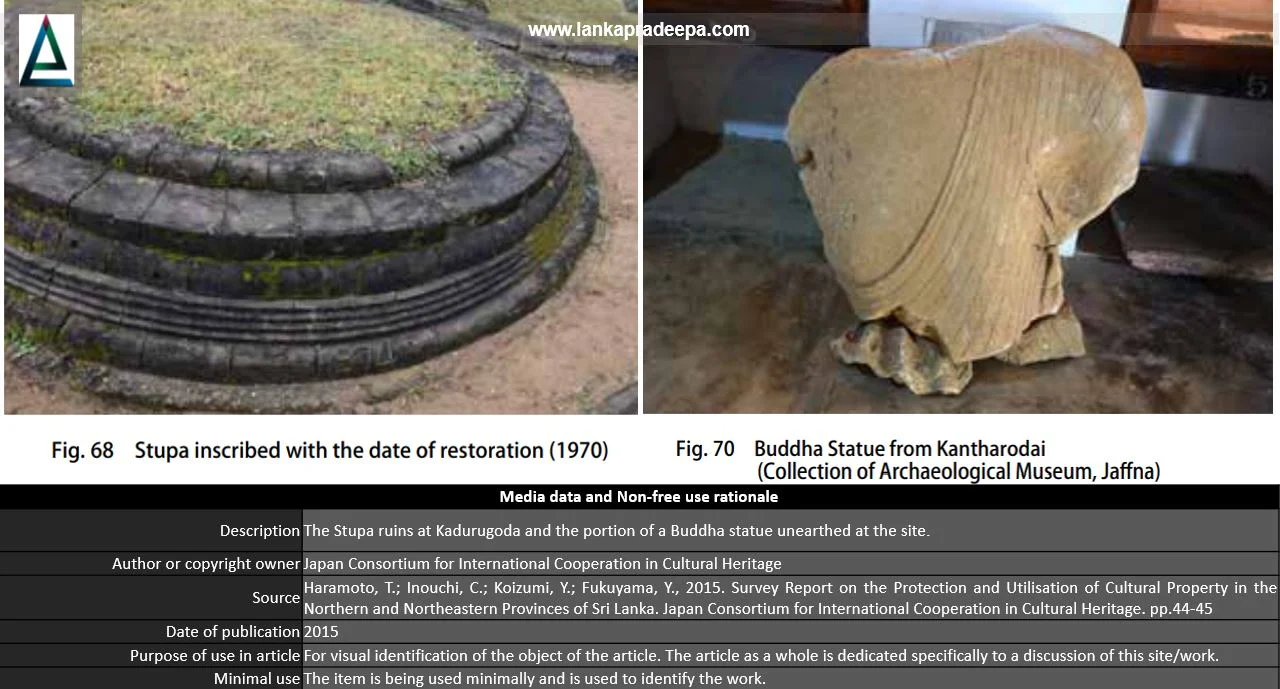
Kadurugoda Viharaya (also known as Kantarodai Archaeological Reserve) is located in the hamlet of Kantarodai in Chunnakam, Jaffna District, Sri Lanka.
Ancient settlement
According to Dr Siran Deraniyagala, Kadurugoda human settlement surrounding the Kadurugoda temple is one of the ancient settlements (after Anuradhapura, Tissamaharama, and the hinterland of Mahatittha port in Mannar) discovered so far in Sri Lanka (Deraniyagala, 2007; Dias et al., 2016). Various artefacts unearthed from this site confirm that Kadurugoda was an important urbanized site that existed from the beginning of the proto-historic period. Presently, most of the remaining monuments at the site are Buddhist Stupas built of coral stone (Uduwara & Wijesekara, 1990).
History
The history of the Kadurugoda temple is linked by chronicles to the arrival of Ven. Sanghamitta Threi in Sri Lanka (Dias et al., 2016). The temple is also referred to in 'Nampotha', a book compiled during the 15th century, as Kadurugoda Viharaya of the Demalapattanama (Godakumbura, 1968; Pieris, 1917; Uduwara & Wijesekara, 1990).
Folklore
According to a historic legend, the lord Buddha resolved a dispute that occurred between two Naga kings named Chulodara and Mahodara in Nagadipa over the possession of a gem-studded throne. After settling the dispute, the Buddha is said to be here in retreat for some time. Also, it is believed that the ashes received after the cremation of 60 Arhats who lived in Puvanativu (Punkudutivu) have been entombed at this site (Wijebandara, 2014).
Etymology
There are several theories explaining the evolution of the present Tamil name, Kantarodai from the Sinhalese word Kadurugoda. P.E. Pieris points out that the intermediate stage of the name of the Kadurugoda appears in Mascarenhas' Foral as Candaracudde where cudde has been taken from 'koda' which is the Tamil pronunciation evolved from the Sinhalese word 'goda'. Soon the word 'koda' was developed into 'oda' and then into Tamil 'odai' (Pieris, 1917). The descriptive name 'goda', according to Pieris, can be well applied to the village as the noticeable undulating nature of the ground.
According to another theory, the name Kadurugoda is thought to have evolved from Kandavurugoda, a Sinhalese word used to denote a site of military encampment (Wijebandara, 2014).
P. E. Pieris & Kadurugoda

The site was first identified in 1917 by P. E. Pieris, the then-district judge for Jaffna. He found these mounds of Stupas while inspecting the tumulus which had been observed by him some months ago during one of his visits to Kankasanturai. According to him, it was the first discovery of a Dagoba in Jaffnpatam (Pieris, 1917). He carried out small-scale excavations at the site and found a number of artefacts including limestone spires/finials of Dagobas, the brick platform of a Dagoba, specimens of stone works, pieces of tiles, fragments of large Buddha statues, etc. (Pieris, 1917). He also recorded an image of the Buddha which was discovered in 1902 at Koddiya Wattai, a hamlet of Chunnakam. In his article, Pieris describes how the ruins at Koddiya Wattai and Kantarodai in Chunnakam had been vandalized by the local people.
Till six years ago the Garbha had risen about twelve feet above the platform; and then came the usual vandal, who has done so much stupidly ignorant mischief to valuable antiquities, and cartloads of the dagoba stones were dug out with pickaxes and removed for use on the railway line. Fortunately the coral mouldings hidden in the earlier debris, escaped.It was, however, the wells which soon began to attract our attention; their number is great and the majority of them are built up of wedge-shaped coral blocks taken from dagobas, while set in the plaster works are ancient roofing tiles. At one of these wells was half a stone Kota, and low down in another was a portion of a stone frieze, pointed out to me by a little boy who knew it as the "Bride and Bridegroom".
Often the shrine consists of nothing more than an iron trident fixed on a stone or log of wood and placed under a tree. Opposite this is set up a block of hard stone against which on solemn occasions coconuts are broken to the honour of the deity, and several of the Kotas were found utilized for this purpose, being fixed in the ground with the base uppermost.
The large fragment of the torso of what must have been at one time a gigantic statue was being used at a well for washing clothes on.
Citation: Pieris, P. E., 1917. pp. 21,23-25.
More details about the discoveries at Kantarodai were given by Pieris in his second article published in 1919. A Sri Pathul Gala (Foot of the Buddha), glazed tiles, carnelian ornaments, Roman coins, Puranas, Lakshmi coins, Setu coins, Lion coins and Massas of Parakramabahu I (1153-1186 A.D.), Coins of Sri Dammasokadeva (1208-1209 A.D.), Buwnekabahu, Srimat Sahassamalla (1200-1202 A.D.), Sri Raja Lilawati (1197-1200, 1209-1210, 1211-1212 A.D.), Portuguese and Dutch were some of the artefacts he had found (Pieris, 1919).
After the discovery of the site, the British rulers declared 72 acres of land as an archaeological reserve (Dias et al., 2016). In 1948, the Department of Archaeology purchased the surrounding area with the objective of protecting the site (Haramoto et al., 2015). However, ownership was transferred to a Tamil resident in the vicinity thereafter, and today the Department of Archaeology exercises control only over a plot of land of about 2 square km (Haramoto et al., 2015).
Among a large number of artefacts and ruins found from Kadurugoda excavations, the fragment of the stone pillar which is about 2 feet 7 inches in height is considered more important (Dias et al., 2016). It contains an inscription of Sinhalese scripts of the 10th century on three of its four surfaces. On the fourth surface, an outline drawing of Dhamma Chakraya or the sun is visible (Dias et al., 2016; Ranawella, 2004). The upper part of the pillar is end with a pot of a special shape (Godakumbura, 1968).
A regal proclamation of the bequest of gifts and benefits to a Buddhist place of worship is recorded in the pillar. The preserved fragment does not contain the name of the king or the date of its issue (Ranawella, 2004). However, the donor here is mentioned as the king of the lineage Okavak and the ruler of Ruhuna. Depending on the morphology of the language used, some scholars dated this proclamation to King Kassapa IV [(898-904 A.D.) Dias et al., 2016; Godakumbura, 1968; Wijebandara, 2014]. However, presently, scholars such as Prof. Sirimal Ranawella have dated this inscription to the reign of King Dappula IV [(923-935 A.D.) Ranawella, 2004].

Kadurugoda Pillar Inscription
Reign: Dappula IV (923-935 A.D.)
Period: 10th century A.D.
Script: Medieval Sinhala
Language: Medieval Sinhala
From the excavations done in 2011 by the Ministry of National Heritage, archaeologists unearthed more artefacts including beads, glasses, coins, parts of the animal, carnelian rings, clay pots, and begging bawls inscribed with Brahmi scripts (Dias et al., 2016).


 .
.
Transcript: (Svasti) siribara (Kat)kula kot O(ka)vas parapu(re)n himi vu Ruhun danavu Malamandulu......>>
Translation: Hail!....who secured for himself the Malamandalas of the province of......>>
Content: The inscription is about a proclamation prohibiting the royal officers from entering the boundaries of the Abhayagiri Vihara for official work.
Translation: Hail!....who secured for himself the Malamandalas of the province of......>>
Content: The inscription is about a proclamation prohibiting the royal officers from entering the boundaries of the Abhayagiri Vihara for official work.
References: Ranawella, 2004. The information board by the Department of Archaeology and Ministry of National Heritage.
Excavations
In 1965, Charles Godakumbua, the then Archaeological Commissioner of Sri Lanka carried out several excavations at the site and found artefacts dating from the pre-Anuradhapura Period up to 910 A.D. (Dias et al., 2016). From these studies, he could expose 21 Stupas and ruins of 30 Stupa foundations (Dias et al., 2016).
Vimala Begley who also conducted excavations at Kantarodai found a substantial amount of potsherds that parallel the Iron Age and early historical wares of South India [i.e., the so-called "Megalithic" black and red ware and the rouletted ware of the Arikamedu type and its many variants (Begley, 1967)]. Some of the sherds found in Kantarodai were also similar to those found in Anuradhapura indicating the contact between the two locations (Begley, 1967). Iron slags, coral pieces, a fragmentary Lakshmi plaque, and potteries of local, Roman and South India were among the other artefacts Begley found.
-
Kadurugoda Potsherd with Brahmi Scripts
Scripts : Brahmi
Language : Sinhala Prakrit
Transcript : Datahapata
Translation : Datta's begging bowl
In 1970, a team of archaeologists from Pennsylvania University, USA discovered a potsherd with a lithic inscription of a few letters and labelled it as KTDA14 (Dias et al., 2016). It contains 6 letters and the first one has been identified as "Ma" which according to Dr Saddhamangala Karunaratna, is a symbol. Similar kinds of symbols have been identified in several Early Brahmi Inscriptions in the country such as Periyankulama, Nattukanda, Thonigala, and Paramakanda (Dias et al., 2016). Dr Malini Dias et al. (2016) have cited Professor Karthigesu Indrapala's (1973) observations regarding this potsherd in their book as follows;
There seems to be no difficulty in reading the inscription as the letters are clearly inscribed. The inscription reads as "datahapata". The script which is similar to the script found in early Brahmi inscriptions found in various parts of the country belongs to the 2nd century B.C. Its language bears the same language used in the pre Christian cave inscriptions. It is in Sinhala Prakrit. "Datahapata" means Dattaha's begging bowl. The correct form of "Datah" in Sanskrit is Dattah. This is described to be a typical name found freely in early Brahmi cave inscriptions. The word "pata" although not in the cave inscriptions is found in the Brahmi scripted potsherd discovered in Anuradhapura. While it is a Prakrit word it means "Patra" in Sanskrit.Cross citation: Dias et al., 2016. pp. 222-223.
A protected site
The Kadurugoda settlement in the Grama Niladhari Division of Kantharodey (GND No. J-200) in the Divisional Secretary’s Division of Uduvil is an archaeological protected site, declared by a government gazette notification published on 17 May 2013.


 .
.
References
1) Begley, V., 1967. Archaeological exploration in northern Ceylon. Expedition, 9(4), pp.20-29.
2) Deraniyagala, S.U., 2007. The prehistory and protohistory of Sri Lanka. Central Cultural Fund. p.67.
3) Dias, M.; Koralage, S.B.; Asanga, K., 2016. The archaeological heritage of Jaffna peninsula. Department of Archaeology. Colombo. pp.199-200,222-223.
4) Godakumbura, C.E., 1968. Kantarodai. The Journal of the Ceylon Branch of the Royal Asiatic Society, 12, pp.67-85.
5) Haramoto, T.; Inouchi, C.; Koizumi, Y.; Fukuyama, Y., 2015. Survey Report on the Protection and Utilisation of Cultural Property in the Northern and Northeastern Provinces of Sri Lanka. Japan Consortium for International Cooperation in Cultural Heritage. pp.44-45.
2) Deraniyagala, S.U., 2007. The prehistory and protohistory of Sri Lanka. Central Cultural Fund. p.67.
3) Dias, M.; Koralage, S.B.; Asanga, K., 2016. The archaeological heritage of Jaffna peninsula. Department of Archaeology. Colombo. pp.199-200,222-223.
4) Godakumbura, C.E., 1968. Kantarodai. The Journal of the Ceylon Branch of the Royal Asiatic Society, 12, pp.67-85.
5) Haramoto, T.; Inouchi, C.; Koizumi, Y.; Fukuyama, Y., 2015. Survey Report on the Protection and Utilisation of Cultural Property in the Northern and Northeastern Provinces of Sri Lanka. Japan Consortium for International Cooperation in Cultural Heritage. pp.44-45.
6) Pieris, P.E., 1917. Nagadipa and Buddhist remains in Jaffna. The Journal of the Ceylon Branch of the Royal Asiatic Society, (Vol. 26). pp.11-30.
7) Pieris, P.E., 1919. Nagadipa and Buddhist remains in Jaffna: Part II. The Journal of the Ceylon Branch of the Royal Asiatic Society, (Vol. 28). pp.40-67.
8) Ranawella, G.S., 2004. Inscription of Ceylon: Containing pillar inscriptions and slab inscriptions from 924 AD to 1017. Volume V, Part II. Department of Archaeology. pp.103-104.
9) The Gazette of the Democratic Socialist Republic of Sri Lanka, no: 1811. 17 May 2013. p.423.
10) Uduwara, J.; Wijesekara, N. (Editor in chief), 1990. History of the Department of Archaeology,1970-1990. Archaeological Department Centenary (1890-1990): Commemorative series: Volume I: History of the Department of Archaeology. p.175
11) Wijebandara, I.D.M., 2014. Yapanaye Aithihasika Urumaya (In Sinhalese). Published by the editor. ISBN-978-955-9159-95-7. pp.37, 93-98.
8) Ranawella, G.S., 2004. Inscription of Ceylon: Containing pillar inscriptions and slab inscriptions from 924 AD to 1017. Volume V, Part II. Department of Archaeology. pp.103-104.
9) The Gazette of the Democratic Socialist Republic of Sri Lanka, no: 1811. 17 May 2013. p.423.
10) Uduwara, J.; Wijesekara, N. (Editor in chief), 1990. History of the Department of Archaeology,1970-1990. Archaeological Department Centenary (1890-1990): Commemorative series: Volume I: History of the Department of Archaeology. p.175
11) Wijebandara, I.D.M., 2014. Yapanaye Aithihasika Urumaya (In Sinhalese). Published by the editor. ISBN-978-955-9159-95-7. pp.37, 93-98.
Explore Other Nearby Attractions
Location Map (Google)
This page was last updated on 7 December 2023

